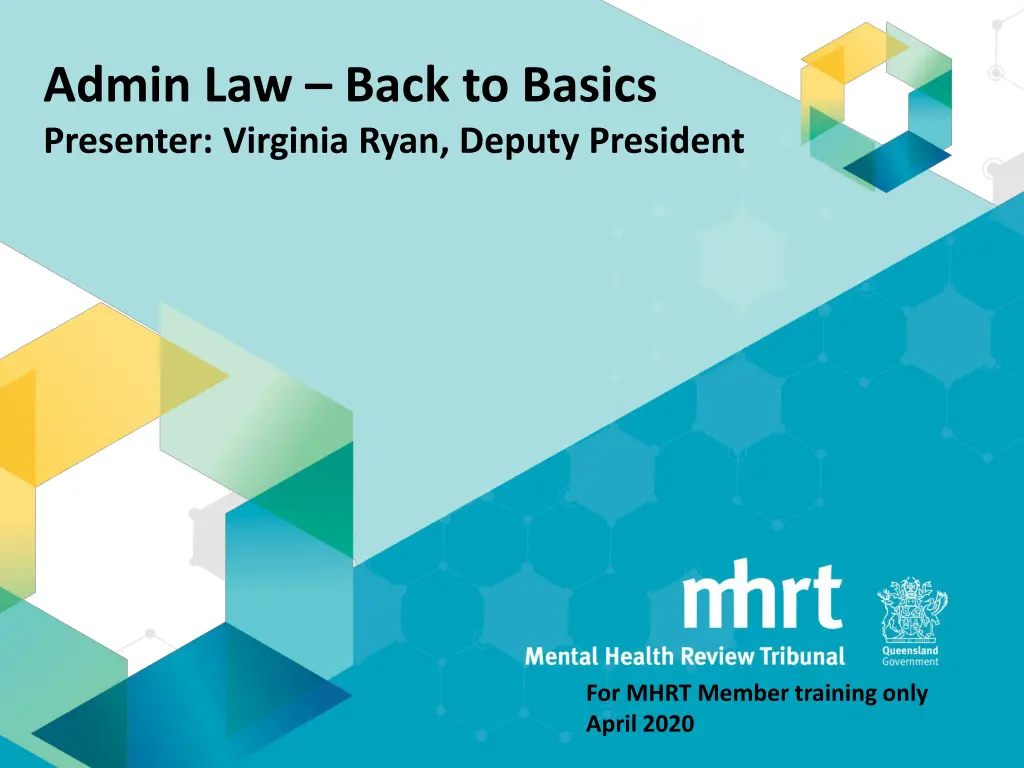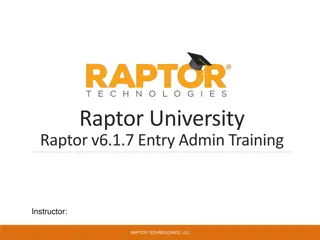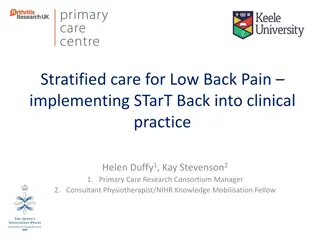
Understanding Administrative Law Fundamentals and Decision-Making Process
Dive into the essentials of administrative law, exploring topics like separation of powers, sources of power, rules of natural justice, and the distinction between judicial and administrative decision-making. Learn how administrative bodies like the Mental Health Review Tribunal make authoritative and lawful decisions within defined boundaries.
Download Presentation

Please find below an Image/Link to download the presentation.
The content on the website is provided AS IS for your information and personal use only. It may not be sold, licensed, or shared on other websites without obtaining consent from the author. If you encounter any issues during the download, it is possible that the publisher has removed the file from their server.
You are allowed to download the files provided on this website for personal or commercial use, subject to the condition that they are used lawfully. All files are the property of their respective owners.
The content on the website is provided AS IS for your information and personal use only. It may not be sold, licensed, or shared on other websites without obtaining consent from the author.
E N D
Presentation Transcript
Admin Law Back to Basics Presenter: Virginia Ryan, Deputy President For MHRT Member training only April 2020
Introduction What is administrative law? Separation of powers Sources of power for administrative decision makers Rules of natural justice / procedural fairness Hearing Rule Bias Rule including Conflict of Interest
What is Administrative Law? The remedies and procedures for challenging decisions made by Government agencies and public officials. Judicial review has focused on the powers (or jurisdiction) exercised by a public agency or administrative official and the procedures it uses in exercising its powers. A body of principles which decision makers should apply in order to make sound, unassailable decisions has developed.
Separation of Powers Legislative power the Parliaments of the Commonwealth and the States/Territories they make the laws Executive power the Crown represented by the Governor-General/Governor and the Ministers supported by their administrative departments and agencies Judicial power the Judiciary They do not usurp each others roles: Courts do not make legislation and Parliaments do not conduct criminal trials.
MHRT Administrative decision-making? The distinction between judicial and administrative decision-making can be quite difficult to determine. MHRT exercises the authority it has in a quasi-judicial way but may be making administrative decisions. We won t dig down too deep into the distinction let s keep it simple.
Sources of power The exercise of power must be based on legal authority. The MHRT is created by and gets its power from the Mental Health Act 2016. We cannot make decisions that we don t have power to make. Must stick within the boundaries of what the MHA2016 says.
Rules of natural justice / procedural fairness These are the common law equivalent of a constitutional guarantee of due process. They apply to tribunals and administrative decision makers. A failure to apply these rules may mean a decision maker has acted unlawfully. MHA2016: Section 733(3)(a): In conducting a proceeding, the MHRT must observe the rules of natural justice. There are other specific provisions that place obligations on the MHRT that are related to achieving natural justice: s734 parties must be given reasonable opportunity to present their case. s738 parties must give copies of documents they will rely upon to all other parties.
Rules of natural justice / procedural fairness cont. Focus is not on whether the decision is correct but how the decision maker got to that decision the process. The demands of fairness and how to apply each rule depends on the context. Thus, the rules are somewhat imprecise. Needs to be thought of on an individual basis not applying a blanket rule to everyone, all the time. Similar in concept to how we apply human rights considerations. We ll consider: Hearing rule. Bias rule.
Hearing Rule An opportunity to be heard where the person s interests are affected by a decision. Could be the patient being heard about their own interests. Could be the Attorney-General who represents the community s interests. Prior notice that the decision is to be made. MHRT is required to provide written notice to the parties within timeframes specified in the MHA2016. A right to know what information / evidence is taken into account and to respond to any adverse information from whatever source. Requirement for parties to disclose documents to other parties - s738. Requirement on treating teams to provide clinical reports to patients at least 7 days prior s723. Right to appear at the hearing and hear the oral evidence s736. Members cannot have information in their mind that they use to make the decision without bringing that to the attention of all parties. E.g. content from Google searches, knowledge from CIMHA, knowledge from previous hearings.
Hearing Rule Cont. A right to legal representation or support person. All persons the subject of the hearing have a right to be represented s739 All persons the subject of the hearing have a right to a support person s739 The MHRT must provide certain persons with legal representation free of charge and the MHRT can provide a legal representative outside of those circumstances where they consider it is in the person s best interests s740 A right to reasons for the decision. Specified persons are entitled to request a written statement of reasons from the MHRT s756 A right to a hearing or ability to lodge written submissions. Persons who are entitled to notice are entitled to appear at the hearing s736 EXCEPT if they received notice pursuant to s287 (e.g. personal guardian).
Hearing Rule Not never-ending The hearing rule must be applied fairly and having regard to the circumstances. While a patient has a right to be heard, the MHRT is also required to discharge its obligations as quickly, and with as little formality and technicality, as is consistent with a fair and proper consideration of the matters before it. So, patient and other parties do not have the right to speak for as long as they want on any topic they want. Also, the MHRT does not have to accept and read voluminous written documents.
Bias Rule The decision maker must not have an interest in the outcome of a decision. There must not be an actual bias or the perception/apprehension of bias.
Actual vs Apprehension Actual means that the decision maker has a predisposition to make a decision without an impartial and unprejudiced mind. Apparent means that a fair-minded observer might reasonably think that the decision maker is not impartial. Can arise from what someone says or does. Can be about forming a prejudgment and not being open to persuasion. Could be showing favouritism to one party over another. It is not about whether the person thinks the decision maker is biased OR whether the decision maker is confident they won t be biased it is about whether a fair-minded observer would reasonably suspect bias.
Pre-reading the material Case law tells us that pre-reading the hearing material that the parties have is not bias. No fair minded party or observer would apprehend bias because the court or tribunal has read in advance of the hearing background material which is available to be read on a court or tribunal file. That this will usually happen is these days to be expected. Winter v Australian Securities Commission
Conflict of Interest A personal interest in the outcome, whether pecuniary or otherwise. Most often arise due to social, political, family, religious or personal relationships. The issue is the actual or apparent influence on a person s ability to be impartial. Objective test: what would a member of the public think? Refer to the MHRT s Conflict of Interest Practice Guideline.






















